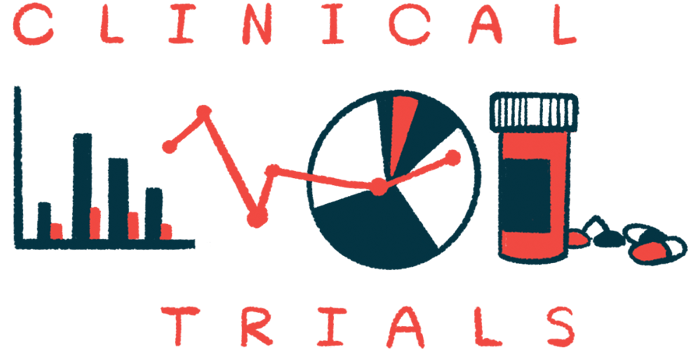Gene therapy at low dose helps two OPMD patients with swallowing
Reasonable safety with BB-301 also being seen in enrolling clinical trial

A single low dose of the investigational gene therapy BB-301 helped with swallowing for the first two people with oculopharyngeal muscular dystrophy (OPMD) treated in a Phase 1b/2a clinical trial, according to an update from the therapy’s developer, Benitec Biopharma.
Trial findings to date, which include reasonable treatment safety being seen, were presented at the 29th Annual Congress of the World Muscle Society recently held in Prague, and are detailed in an investor presentation.
“We are highly encouraged by the significant, clinically meaningful improvements observed for both subjects treated at the low-dose of BB-301,” Jerel A. Banks, MD, PhD, executive chairman and CEO of Benitec, said in a company press release.
Trial enrolling children, adults taking part in an OPMD natural history study
A third patient will be treated at the same low dose of BB-301 this month, Banks said. The company plans for additional dosing in this patient group and the next highest dose group to continue throughout this year and next.
The open-label Phase 1b/2a trial (NCT06185673) is recruiting up to 30 OPMD patients, children through adults up to age 65, at its New York University Langone Health site. Eligible participants will have completed at least six months of observation without treatment in a separate Benitec-sponsored natural history study of OPMD, in which evaluations show evident swallowing difficulties.
“We are optimistic about the potential for continued benefit in subjects enrolled in the ongoing study,” Banks said. As of January, the company reports, 23 patients were taking part in the natural history study.
OPMD is a type of muscular dystrophy characterized by weakness in the muscles that control the eyelids and throat.
Patients experience swallowing problems (dysphagia) that worsen over time and ultimately can lead to malnutrition or aspiration pneumonia, a life-threatening complication that occurs when food and liquids enter the airways during swallowing.
The disease arises from mutations in the PABPN1 gene that result in the production of an abnormal protein that forms damaging clumps in muscle cells, impairing the ability of the throat muscles to propel food and liquid into the digestive tract.
BB-301 is given to deactivate, then replace, PABPN1 gene in throat muscles
BB-301 uses Benitec’s proprietary “Silence and Replace” platform to simultaneously deactivate the faulty PABPN1 gene and provide muscle cells with a new, functional version of it. This is expected to improve the strength of throat muscles needed for swallowing.
The trial, cleared by U.S. regulators last year, is evaluating BB-301’s safety and its effects on swallowing in OPMD patients. In its Phase 1b part, patients are being treated sequentially at three different dose levels in order to select an optimal gene therapy dose to be tested during the trial’s Phase 2a part.
The first treated participant was given the lowest dose of BB-301 (1.2 x 10^13 vector genomes), injected directly into the throat muscles during surgery under general anesthesia in November 2023, followed by a second participant given the same dose in February.
Preliminary data, reported by Benitec in July, indicated that the first patient showed improvements in swallowing abilities at six months post-treatment, relative to what had been observed for this person in the natural history study.
Newly reported findings covered nine months of follow-up for that patient and six months of follow-up for the second patient. Benitec indicated that no significant adverse events were reported for either participant.
Trial monitoring treatment safety, changes in swallowing abilities
Swallowing function is being evaluated by monitoring total pharyngeal residue (TPR), which measures how much food or liquid is left in the throat after swallowing. A lower pharyngeal residue score reflects better swallowing abilities. Patient-reported swallowing abilities were assessed with the Sydney Swallow Questionnaire (SSQ).
According to Benitec, the first patient generally had more severe dysphagia than the second one prior to receiving BB-301, and both experienced significant improvements with the therapy.
The first patient continued to see clinically meaningful reductions in TPR nine months after receiving BB-301 — including when swallowing thin liquids (a 33% reduction), thick liquids (30% reduction), and solid foods (18% reduction) — relative to their average swallowing abilities in the natural history study.
This corresponded with significantly better scores on the SSQ for each of those food consistencies. The total SSQ score significantly improved by 35% relative to the patient’s average natural history study score.
The second treated patient also exhibited stabilizations or clinical improvements in TPR across the different food consistencies. The total SSQ score improved by 89% relative to this person’s average pre-treatment levels, with their SSQ scores six months after treatment reflecting clinically normal swallowing.
According to Benitec, this patient’s swallowing dysfunction largely was due to pathologic low-volume sequential swallows for thin liquids, which essentially means a person needs several small swallows to clear these liquids because the swallows are not forceful enough.
TPR data showed the second patient experienced a 92% reduction in pathologic low-volume sequential swallows for thin liquids six months after treatment, corresponding with an 84% score improvement on the SSQ question evaluating that symptom.
Swallowing function and therapy safety will continue to be monitored in trial participants across one year.
“We are grateful to the subjects and their families for their strong support and continued participation in the BB-301 clinical development program,” Banks said.







